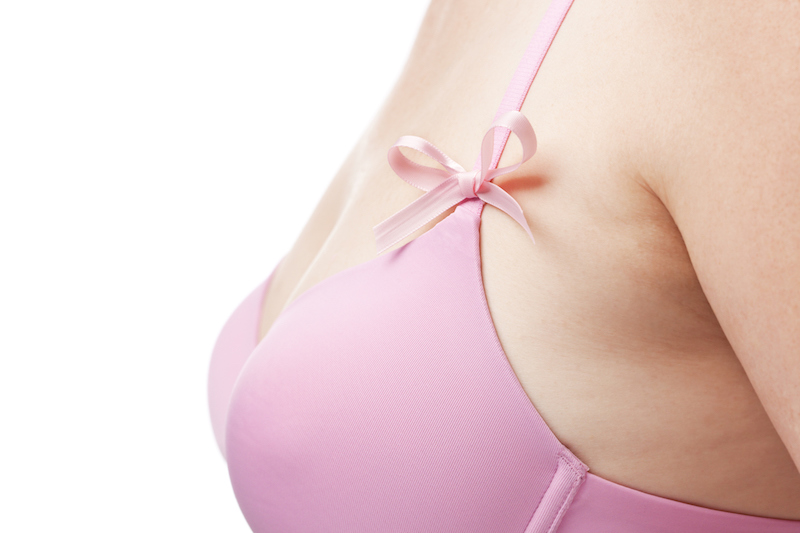Aside from breast cancer, our chief concern about aging breasts was sagging. Just how long would it be before our boobs drooped so low they’d graze our waistband? Though some things are within our control — despite the fact that 80 percent of women still wear the wrong size bra — when it comes to breast changes with age, our cup runneth over.
Many of the changes are because of falling estrogen after 40.
The Usual Suspects
We expect changes in breast firmness and fullness due to pregnancy and weight gain (or loss), but it was news that estrogen was the culprit for drooping. Estrogen helps keep mammary glands and connective tissues plump and hydrated. Without it, breasts lose volume and skin becomes less elastic. Even when fat fills in the volume vacancy (keep reading), breasts are soft rather than firm.
And regardless of size, with age comes an increased risk of abnormal growths. Lumps are common around the time of menopause, according to the U.S. National Library of Medicine. Thanks to decades of activism and the Susan G. Komen Foundation, we are aware of the importance of being committed to self-exams and annual mammograms. The good news is that most breast lumps are nothing to worry about.
Fat Migration and Redistribution
When writer Andrea Warren feels lumps in her armpits in an episode of her hilarious Netflix sitcom, I’m Sorry, we crossed our arms and pushed our fingers into our own armpits to feel around. Warren sees her doctor about what turns out to be something called “accessory axillary breast tissue” — or what she deems “extra boobs.” In 2 to 5 percent of women, breast tissue migrates to locations other than the breast (how bizarre!). Doctors recommend having it surgically removed.
But accessory axillary breast tissue is just one example of age-related shape shifting. Weight gain and fat redistribution are others. As estrogen declines, weight once carried in the hips, thighs, and buttocks can gravitate to the abdomen among other areas. What’s more, breasts go through “involution,” which is when milk-producing glands shut down and breast tissue is replaced by fat.
~
Beyond gaining a cup size and seeing armpit fat, or “sleevage” as Dr. Pamela Peeke calls it, you may see an increase in back fat and fat along your ribcage, below the breasts.
~
That’s one factor that may cause many women to experience an increase in cup size. Research has shown that one in five women grow two or more cup sizes around the time of menopause, though “the most important factor associated with such an increase was found to be weight gain.” Beyond gaining a cup size and seeing armpit fat, or “sleevage” as Dr. Pamela Peeke calls it, you may see an increase in back fat and fat along your ribcage, below the breasts.
With diet and exercise you can control some fat redistribution and weight gain, according to trainer and nutritionist Lauren Simmons. She recommends tracking macronutrients to ensure you get enough protein (20-30 percent of your overall calories), carbohydrates (50 percent), and healthy fats (20 percent), with the overall goal of taking in fewer calories than you expend. When good nutrition is coupled with strength training, which not only increases muscle mass but enhances metabolism, you can fight age-related fat.
Simmons is a proponent of squats, lunges, the chest press, and rows — as they all use large muscle groups — to burn the most calories and build muscle. And she reminds us that spot reduction is a myth — that you cannot reduce fat in just one area at a time. So working the chest (with pullups, chinups, and cable pulldowns) and back (with bench press, chest fly, pushups, and shoulder press) can help build muscle and reduce body fat overall, but it will not eliminate underarm fat or back fat specifically.
Crepey Skin and Nipple Changes
If you’ve started to notice a crepey décolletage, you can thank the age-related breakdown of collagen. According to breast plastic surgeon Dr. Alexes Hazen, sunscreen is essential protection for breasts. “If some breast skin is exposed, it will age just like any other skin on your body that is exposed to sun.”
Less sensitivity to touch is also a factor as you age. “Sensations you feel around the nipple and areola come from nerves inside the chest. If you have small breasts, the distance to the nerves is really short, so you may have more sensitivity. As they grow or droop over time, though, that nerve gets stretched out and the sensation may lessen,” says Hazen. You might also notice that your areola (the area around the nipple) shrinks. In some women, it might nearly disappear.
Breasts Aren’t Everything
It may feel stressful to endure significant changes in your body, especially when mentally you don’t feel a day over 35, but don’t let breast changes get you down.
Keep an eye on things. If something seems suspicious, see your doctor. But most likely all you need to do is get a bra fitting, invest in bras that do your figure justice, and know that every woman is more than the sum of her parts.
Photo: YinYang
